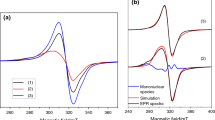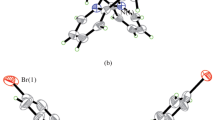Abstract
Increasing inefficiency of production of important agricultural plants raises one of the biggest problems in the modern world. Herbicide application is still the best method of weed management. Traditional herbicides blocking only one of the plant metabolic pathways is ineffective due to the rapid growth of herbicide-resistant weeds. The synthesis of novel compounds effectively suppressing several metabolic processes, and therefore achieving the synergism effect would serve as the alternative approach to weed problem. For this reason, recently, we synthesized a series of nine novel Cu(II) complexes and four ligands, characterized them with different analyses techniques, and carried out their primary evaluation as inhibitors of photosynthetic electron transfer in spinach thylakoids (design, synthesis, and evaluation of a series of Cu(II) based metal–organic complexes as possible inhibitors of photosynthesis, J Photochem Photobiol B, submitted). Here, we evaluated in vitro inhibitory potency of these agents against: photochemistry and carbonic anhydrase activity of photosystem II (PSII); α-carbonic anhydrase from bovine erythrocytes; as well as glutathione reductase from chloroplast and baker’s yeast. Our results show that all Cu(II) complexes excellently inhibit glutathione reductase and PSII carbonic anhydrase activity. Some of them also decently inhibit PSII photosynthetic activity.






Similar content being viewed by others
Abbreviations
- PSII, PSI:
-
Photosystem II and photosystem I, respectively
- GSH:
-
Reduced glutathione
- GSSG:
-
Oxidized glutathione disulfide
- F o, F m :
-
Minimum and maximum chlorophyll fluorescence intensity emitted by dark-acclimated samples, respectively
- F v/F m :
-
Maximum quantum yield of primary photosystem II photochemistry
- EDTA:
-
Ethylenediaminetetraacetic acid
- TyrZ:
-
Tyrosine Z, redox active tyrosines in the D1 protein of PSII
- P680 :
-
PSII reaction center chlorophyll dimer
- GR:
-
Glutathione reductase
- DMSO:
-
Dimethyl sulfoxide
- CA:
-
Carbonic anhydrase
- Q A, Q B :
-
Primary and secondary quinone electron acceptors of PSII
- NADFH:
-
Nicotinamide adenine dinucleotide phosphate, reduced form
- QSAR:
-
Quantitative structure–activity relationship
- IC50 :
-
Half maximal inhibitory concentration
- pIC50 :
-
−log10(IC50)
- HOMO:
-
Highest occupied molecular orbital
References
Alscher RG (1989) Biosynthesis and antioxidant function of glutathione in plants. Physiol Plant 77:457–464. doi:10.1111/j.1399-3054.1989.tb05667
Anderegg G, International Union of Pure and Applied Chemistry. Commission on Equilibrium Data (1977) Critical survey of stability constants of EDTA complexes: critical evaluation of equilibrium constants in solution; part A: stability constants of metal complexes. Pergamon Press, Oxford
Anderson NG, Wilbur KM (1948) Electrometric and colorimetric determination of carbonic anhydrase. J Biol Chem 176:147–154
Arnon DI (1949) Copper enzymes in isolated chloroplasts. Polyphenoloxidase in Beta vulgaris. Plant Physiol 24(1):1–15
Baron M, Arellano JB, Gorge JL (1995) Copper and photosystem II: a controversial relationship. Physiol Plant 94:174–180
Baszynski T, Krupa Z (1995) Some aspects of heavy metals toxicity towards photosynthetic apparatus—direct and indirect effects on light and dark reactions. Acta Physiol Plant 17:177–190
Beckie HJ, Tardif FJ (2012) Herbicide cross resistance in weeds. Crop Prot 35:15–28
Burda K, Kruk J, Schmid GH, Strzalka K (2003) Inhibition of oxygen evolution in Photosystem II by Cu(II) ions is associated with oxidation of cytochrome b559. Biochem J 371:597–601
Carlberg I, Mannervik B (1985) Glutathione reductase. In: Meister A (ed) Methods in enzymology. Glutamate, glutamine, glutathione, and related compounds, 1st edn, vol 113. Academic Press, Orlando, pp 484–490
Cedeno-Maldonado A, Swader JA, Heath RL (1972) The cupric ion as an inhibitor of photosynthetic electron transport in isolated chloroplasts. Plant Physiol 50:98–701
Chen H, Chen J, Guo Y, Wen Y, Liu J, Liu W (2012) Evaluation of the role of the glutathione redox cycle in Cu(II) toxicity to green algae by a chiral perturbation approach. Aquat Toxicol 120–12:19–26. doi:10.1016/j.aquatox.2012.04.011
Cid A, Herrero C, Torres E, Abalde J (1995) Copper toxicity on the marine microalga Phaeodactylum tricornutum: effects on photosynthesis and related parameters. Aquat Toxicol 31(2):165–174. doi:10.1016/0166-445X(94)00071-W
Clijsters H, Van Assche F (1985) Inhibition of photosynthesis by heavy metals. Photosynth Res 7:31–40. doi:10.1007/BF00032920
Cobb AH, Reade JPH (2010) Herbicides and plant physiology: second edition. Wiley-Blackwell, Chichester
Connell JP, Mullet JE (1986) Pea chloroplast glutathione reductase: purification and characterization. Plant Physiol 82:351–356
Dasgupta J, Ananyev GM, Dismukes GC (2008) Photoassembly of the water-oxidizing complex in photosystem II. Coord Chem Rev 252(3–4):347–360. doi:10.1016/j.ccr.2007.08.022
Deng C, Pan X, Wang S, Zhang D (2014) Cu2+ inhibits photosystem II activities but enhances photosystem I quantum yield of Microcystis aeruginosa. Biol Trace Elem Res 160:268. doi:10.1007/s12011-014-0039-z
Deponte M, Urig S, Arscott LD, Fritz-Wolf K, Réau R, Herold-Mende C, Koncarevic S, Meyer M, Charvet ED, Ballou DP, Williams CH, Becker K (2005) Mechanistic studies on a novel, highly potent gold-phosphole inhibitor of human glutathione reductase. J Biol Chem 280:20628–20637. doi:10.1074/jbc.M412519200
Droppa M, Horváth G (1990) The role of copper in photosynthesis. Crit Rev Plant Sci 9(2):111–123. doi:10.1080/07352689009382284
Fangstrom I (1972) The effects of some chelating agents and their copper complexes on photosynthesis in Scenedesmus quadricauda. Physiol Plant 27:389–397. doi:10.1111/j.1399-3054.1972.tb03633.x
Flemming CA, Trevors JT (1989) Copper toxicity and chemistry in the environment: a review. Water Air Soil Pollut 44:143–158. doi:10.1007/BF00228784
Foyer CH, Halliwell B (1976) The presence of glutathione and glutathione reductase in chloroplasts: a proposed role in ascorbic acid metabolism. Planta 133(1):21–25
Goebel CV, Doedens RJ (1971) The crystal and molecular structure of bis(phenoxyacetato)triaquocopper(II), a monomeric, pentacoordinate cupric carboxylate adduct. Inorg Chem 10(11):2607–2613. doi:10.1021/ic50105a048
Halliwell B, Foyer CH (1978) Properties and physiological function of a glutathione reductase purified from spinach leaves by affinity chromatography. Planta 139:9–17
Heyneke E, Luschin-Ebengreuth N, Krajcer I, Wolkinger V, Müller M, Zechmann B (2013) Dynamic compartment specific changes in glutathione and ascorbate levels in Arabidopsis plants exposed to different light intensities. BMC Plant Biol 13:104
Jegerschold C, Arellano JB, Schroder WP, van Kan PJM, Baron M, Styring S (1995) Copper(II) inhibition of electron transfer through photosystem II studied by EPR spectroscopy. BioChemistry 34:12747–12754. doi:10.1021/bi00039a034
Kalt-Torres W, Burke JJ, Anderson JM (1984) Chloroplast glutathione reductase: purification and properties. Physiol Plant 61(2):271–278
Karacan MS, Zharmukhamedov SK, Mamaş S, Kupriyanova EV, Shitov AV, Klimov VV, Özbek N, Özmen Ü, Gündüzalp A, Schmitt FJ, Karacan N, Friedrich T, Los DA, Carpentier R, Allakhverdiev SI (2014) Screening of novel chemical compounds as possible inhibitors of carbonic anhydrase and photosynthetic activity of photosystem II. J Photochem Photobiol B 137:156–167. doi:10.1016/j.jphotobiol.2013.12.002
Karacan MS, Rodionova MV, Tunc T, Venedik KB, Mamas S, Shitov AV, Zharmukhamedov SK, Klimov VV, Karacan N, Allakhverdiev SI (2016) Characterization of nineteen antimony(III) complexes as potent inhibitors of photosystem II, carbonic anhydrase, and glutathione reductase. Photosynth Res 130:167. doi:10.1007/s11120-016-0236-z
Kingston R (2011) Pesticides and herbicides. In: JL Vincent, E Abraham, FA Moore, PM Kochanek, MP Fink (ed) Textbook of critical care, 6th edn. Elsevier Saunders, Edinburgh, pp 1362–1365
Klimov VV, Allakhverdiev SI, Shuvalov VA, Krasnovsky AA (1982) Effect of extraction and re-addition of manganese on light reactions of photosystem-II preparations. FEBS Lett 148(2):307–312. doi:10.1016/0014-5793(82)80830-2
Kráľová K, Šeršeň F, Blahová M (1994) Effects of Cu(II) complexes on photosynthesis in spinach chloroplasts. Aqua(aryloxyacetato)copper(II) complexes. Gen Physiol Biophys 13:483–491
Kráľová K, Kissová K, Švajlenová O, Vančo J (2004) Biological activity of copper(II) N-salicylideneaminoacidato complexes. Reduction of chlorophyll content in freshwater alga Chlorella vulgaris and inhibition of photosynthetic electron transport in spinach chloroplasts. Chem Pap 58(5)357–361
Kramer W, Wiley InterScience, (Online service) (2012) Modern crop protection compounds. Wiley-VCH, Weinheim
Küpper H, Küpper F, Spiller M (1996) Environmental relevance of heavy metal-substituted chlorophylls using the example of water plants. J Exp Bot 47(2):259–266. doi:10.1093/jxb/47.2.259
Mapson LW, Isherwood FA (1963) Glutathione reductase from germinated peas. Biochem J 86:173–191
Martell AE, Smith RM (eds) (1982) Critical stability constants. First supplement. Springer, New York
Mijovilovich A, Leitenmaier B, Meyer-Klaucke W, Kroneck PMH, Götz B, Küpper H (2009) Complexation and toxicity of copper in higher plants. II. Different mechanisms for copper versus cadmium detoxification in the copper-sensitive cadmium/zinc hyperaccumulator Thlaspi caerulescens (Ganges Ecotype). Plant Physiol 151:715–731. doi:10.1104/pp.109.144675
Mohanty N, Vass I, Demeter S (1989) Copper toxicity affects photosystem II electron transport at the secondary quinone acceptor, Q(B). Plant Physiol 90(1):175–179. doi:10.1104/pp.90.1.175
Murakami K, Tsubouchi R, Fukayama M, Yoshino M (2014) Copper-dependent inhibition and oxidative inactivation with affinity cleavage of yeast glutathione reductase. Biometals 27:551–558. doi:10.1007/s10534-014-9731-x
Noctor G, Mhamdi A, Chaouch S, Han Y, Neukermans J, Marquez-Garcia B, Queval G, Foyer CH (2012) Glutathione in plants: an integrated overview. Plant Cell Environ 35(2):454–484. doi:10.1111/j.1365-3040.2011.02400.x
Oerke EC (2006) Crop losses to pests. J Agric Science 144, 31–43. doi:10.1017/S0021859605005708
Ouzounidou G, Moustakas M, Strasser RJ (1997) Sites of action of copper in the photosynthetic apparatus of maize leaves: kinetic analysis of chlorophyll fluorescence, oxygen evolution, absorption changes and thermal dissipation as monitored by photoacoustic signals. Aust J Plant Physiol 4:81–90. doi:10.1071/PP96028
Paulíková H, Berczeliová E (2005) The effect of quercetin and galangin on glutathione reductase. Biomed Pap Med Fac Univ Palacky Olomouc Czech Repub 149(2):497–500
Pospíšil P (2009) Production of reactive oxygen species by photosystem II. Biochim Biophys Acta 1787:1151–1160. doi:10.1016/j.bbabio.2009.05.005
Prout CK, Armstrong RA, Carruthers JR, Forrest JG, Murray-Rust P, Rossotti FJC (1968) Structure and stability of carboxylate complexes. Part 1. The crystal and molecular structures of copper(II) glycollate, dl-lactate, 2-hydroxy-2-methylpropionate, methoxyacetate, and phenoxyacetate. J Chem Soc A. doi:10.1039/J19680002791
Schiller H, Dau H (2000) Preparation protocols for high-activity photosystem II membrane particles of green algae and higher plants, pH dependence of oxygen evolution and comparison of the S2-state multiline signal by X-band EPR spectroscopy. J Photochem Photobiol B 55:138–144. doi:10.1016/S1011-1344(00)00036-1
Schröder WP, Arellano JB, Bittner T, Barón M, Eckert HJ, Renger G (1994) Flash-induced absorption spectroscopy studies of copper interaction with photosystem II in higher plants. J Biol Chem 269(52):32865–32870
Shitov AV, Pobeguts OV, Smolova TN, Allakhverdiev SI, Klimov VV (2009) Manganese-dependent carboanhydrase activity of photosystem II proteins. Biochemistry (Moscow) 74(5):509–517. doi:10.1134/S0006297909050058
Shitov AV, Zharmukhamedov SK, Shutova TV, Allakhverdiev SI, Samuelsson G, Klimov VV (2011) A carbonic anhydrase inhibitor induces bicarbonate-reversible suppression of electron transfer in pea photosystem 2 membrane fragments. J Photochem Photobiol B 104(1–2):366–371. doi:10.1016/j.jphotobiol.2011.04.001
Shutova T, Kenneweg H, Buchta J, Nikitina J, Terentyev V, Chernyshov S, Andersson B, Allakhverdiev SI, Klimov VV, Dau H, Junge W, Samuelsson G (2008) The photosystem II-associated Cah3 in Chlamydomonas enhances the O2 evolution rate by proton removal. EMBO J 27(5):782–791. doi:10.1038/emboj.2008.12
Smith RM, Martell AE (1989) Critical stability constants: second supplement. Springer, New York
Smith G, O’Reilly EJ, Kennard CHL, Stadnicka K, Oleksyn B (1981) Metal-phenoxyalkanoic acid interactions. Part I. Crystal and molecular structures of diaquabis(p-chlorophenoxyacetato)zinc(II). Inorg Chim Acta 41:111–120. doi:10.1016/S0020-1693(00)89315-9
Stauber JL, Florence TM (1987) Mechanism of toxicity of ionic copper and copper complexes to algae. Mar Biol 94:511–519. doi:10.1007/BF00431397
Vencill WK, Nichols RL, Webster TM, Soteres JK, Mallory-Smith C, Burgos NR, Johnson WG, McClelland MR (2012) Herbicide resistance: toward an understanding of resistance development and the impact of herbicide-resistant crops. Weed Sci 60(spI):2–30. doi:10.1614/WS-D-11-00206.1
Vierke G, Struckmeier P (1977) Binding of copper(II) to proteins of the photosynthetic membrane and its correlation with inhibition of electron transport in class II chloroplasts of spinach. Z Naturforsch C 32(7–8):605–610
Wolosiuk RA, Buchanan BB (1977) Thioredoxin and glutathione regulate photosynthesis in chloroplasts. Nature 266:565–567
Yruela I (2005) Copper in Plants. Braz J Plant Physiol 17(1):145–156
Yruela I, Gatzen G, Picorel R, Holzwarth AR (1996a) Cu(II)-inhibitory effect on photosystem II from higher plants. A picosecond time-resolved fluorescence study. Biochemistry 35:9469–9474
Yruela I, Pueyo JJ, Alonso PJ, Picorel R (1996b) Photoinhibition of photosystem II from higher plants: effect of copper inhibition. J Biol Chem 271(44):27408–27415. doi:10.1074/jbc.271.44.27408
Zhang K, Yang EB, Tang WY, Wong KP, Mack P (1997) Inhibition of glutathione reductase by plant polyphenols. Biochem Pharmacol 54(9):1047–1053
Acknowledgements
This study has been supported by the Scientific and Technological Research Council of Turkey (TUBITAK-Project No. 212T089), by the Grants from Russian Foundation for Basic Research (Nos. 16-34-50257, 17-04-01011, 17-54-560012, 17-04-01289), and by Molecular and Cell Biology Programs from Russian Academy of Sciences.
Author information
Authors and Affiliations
Corresponding authors
Rights and permissions
About this article
Cite this article
Rodionova, M.V., Zharmukhamedov, S.K., Karacan, M.S. et al. Evaluation of new Cu(II) complexes as a novel class of inhibitors against plant carbonic anhydrase, glutathione reductase, and photosynthetic activity in photosystem II. Photosynth Res 133, 139–153 (2017). https://doi.org/10.1007/s11120-017-0392-9
Received:
Accepted:
Published:
Issue Date:
DOI: https://doi.org/10.1007/s11120-017-0392-9




